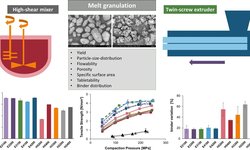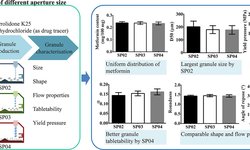Scientific papers
This study investigated how the tabletability and compactibility of granules, formed through twin-screw melt granulation, are influenced by the distribution of binders. Two grades of dicalcium phosphate anhydrous (fine and coarse) were utilized as model substances (filler), along with two grades of poloxamer (fine and coarse) as melt binders at three concentrations. Granule formation followed the immersion mechanism for the fine filler, while a distribution mechanism was observed for the coarse filler. Compared to granules prepared with the coarse filler, those with the fine filler exhibited a more pronounced increase in tabletability compared to the corresponding physical mixtures (PM). In general, tabletability, compressibility, and compactibility were primarily influenced by binder distribution in the tablet, with homogeneous distribution correlating with increased tensile strength. Binder distribution was analyzed using scanning electron microscopy combined with energy-dispersive X-ray analysis (SEM/EDX) and quantified through image analysis of the tablet surface. Physical mixtures, in general, exhibited variation in tabletability. However, even at tabletability levels similar to the granules, all physical mixtures suffered from poor flow and/or segregation.

Comments
No comments posted yet.
Add a comment















